ShopDreamUp AI ArtDreamUp
Deviation Actions
Here's an idea I've been frequently thinking about:
There are no seasons on Aurora because its axis is not tilted like Earth's. There are diurnal „seasons" instead due to the slow rotation period.A lot of water evaporates during the long dry days. A lot of warm, most air rises up from the oceans, which leaves less air left near the surface which causes an area of lower air pressure. The air around this region has higher pressure and rushes in to fill the low pressure area. This air gets warm and moist to and rises too. This cycle keeps going and fuels large cyclones with a lot of rain at dusk.
As night approaches, temperatures drop and the rain becomes snow. A lot of water freezes. Some animals build organic "sleeping bags" to protect themselves against the temperatures and other animals. Photosynthetic plants close up and/or retract as a protective mechanism.
The nights are characterized by cold temperatures and almost no precipitation. Nocturnal animals come out of their burrows and/or cocoons. They are protected agains the cold by a layer of fat and/or feathery scales. Some animals have bioluminescent spots to communicate over ling distances.
At dawn the ice starts melting creating temporary wetlands and marshes. The photosynthetic plants open up again and the nocturnal animals return to their burrows and/or create cocoons to retain moisture.
I have not yet figured out how long the days & nights should be but I was thinking maybe around 40 hours or so… maybe even more
So I have a website now
As part of my last year at art school, I had to make my own website so here it is, in case you are interested :https://www.andreagassler.com There is some stuff I did for school that I have not posted to DA but other than that, there’s not a whole lot you have not yet seen. Anyways, feel free to check it out if you want to
Vacation
Just wanted to give you all a quick heads-up that I’ll be going on vacation in Norway for about five weeks tomorrow so I’ll be even more inactive than usual... Though I will still try to reply to comments and leave comments as best as I can.
What is SSoE and my intentions with it
SSoE stands for «Somewhere, Somewhen on Earth…», the little phrase every description in this project begins with. It is supposed to be a glimpse into another timesteam, exploring one-off scenarios of that could happen/could have happened somewhere on Earth at some point in time – the past, present, future or even in an alternative timeline. These scenarios might be expanded upon in future entries in the project but for now, they’re supposed to be standalone pieces (though there are some crossovers with other projects of mine).
The different uploads in the project feature animals and scenarios that might not otherw
Troubles
Please excuse me taking even more time to reply to comments than I usually do... there’s some indefinable problem with either my computer, the internet connection, DeviantArt or all of them. When on DA, the page often freezes and I can no longer click on anything.
Hopefully, I’ll be able to resolve this problem soon and things will go back to how they usually are
© 2013 - 2024 juniorWoodchuck
Comments10
Join the community to add your comment. Already a deviant? Log In
That sounds awesome.
